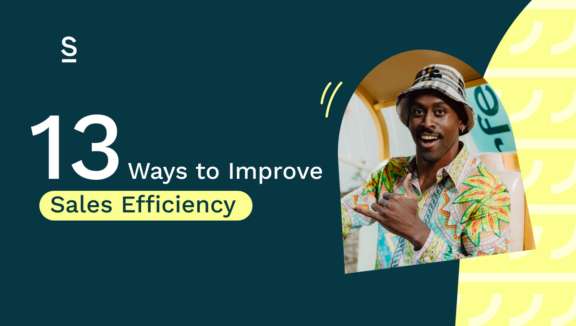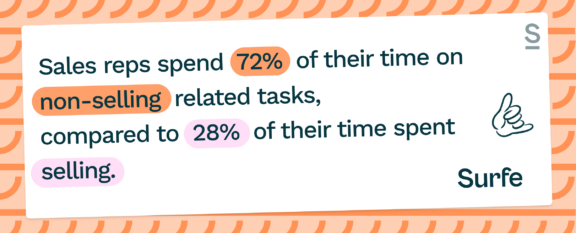13 Ways to Improve Sales Efficiency

To improve sales efficiency is to increase the speed and cost-effectiveness with which leads are converted into sales. The higher your efficiency, the higher your impact, with less time and resources wasted.
Sales reps spend 72% of their time on non-selling related tasks, and only 28% actually selling.
If you could invert those numbers, you’d see a massive increase in revenue.
Understanding how to improve sales efficiency can transform the way your business operates, turning potential into profit more effectively.
Key Takeaways:
1. Clarify Your Objectives and Set Measurable KPIs
Establishing clear business goals is foundational for any successful sales strategy. It aligns the sales team’s efforts with the broader objectives of the company, ensuring everyone is working towards the same target.
By setting specific, measurable, achievable, relevant, and time-bound (SMART) goals, you can create a focused and motivated sales force that understands exactly what is expected of them and why.
The Sales Growth Rate is crucial here, as it directly reflects the effectiveness of sales activities in achieving overarching business objectives, highlighting areas of success and those needing improvement.
This approach not only channels efforts and resources into the most impactful activities but also establishes a clear benchmark for measuring success, ensuring all team members are moving in the same direction.
2. Know Your Ideal Customer
Identifying your ideal customer is vital in crafting sales strategies that resonate with your target audience.
This understanding allows for more personalized communication and product offerings, ensuring that your message reaches those most likely to be interested. By focusing on the specific needs, preferences, and behaviors of your target audience, you can design your sales process to engage them more effectively, enhancing the customer experience from the very first touchpoint.
Lead Conversion Rate is a vital metric in this context, as it measures how effectively your sales team is turning potential leads into actual customers, offering insights into the success of your targeting efforts.
Concentrating on high-potential leads not only streamlines the sales process but also optimizes the use of resources, leading to a more efficient and effective sales operation.
If you want to know more about creating an Ideal Customer Profile, you might be interested in this article:
3. Standardize the Sales Process to improve sales efficiency
A standardized sales process is key to achieving consistency across all sales activities, making it easier to onboard new team members and scale operations efficiently. It defines a clear path from initial contact to closing, ensuring that all sales reps follow the best practices that lead to successful deals.
Monitoring the Sales Cycle Length helps gauge the efficiency of the sales process, indicating how quickly leads move through the sales funnel from initial contact to closed deal.
By streamlining the sales approach, organizations can significantly shorten the sales cycle, allowing sales teams to close deals faster and more efficiently.
4. Outline Daily, Weekly, and Monthly Sales Tasks
By setting clear, structured tasks on a daily, weekly, and monthly basis, sales teams can maintain focus and direction. Daily and weekly tasks enables all team members to be aware of their immediate and long-term responsibilities, and what needs to be done to hit targets.
The Task Completion Rate serves as a vital metric here, measuring the efficiency and reliability with which sales teams meet their objectives, allowing for adjustments and improvements if needed.
Having a regimented organization of tasks does two things:
- helps achieve consistent progress towards sales goals,
- helps in quickly identifying and addressing any bottlenecks, streamlining the path to success.
5. Align Sales and Marketing Efforts
Synchronizing sales and marketing teams ensures that messaging to potential customers is unified and coherent. This alignment is crucial for presenting a consistent brand image and efficiently guiding leads through the sales funnel, from initial awareness to the final purchase decision.
The conversion rate from Marketing Qualified Leads (MQLs) to Sales Qualified Leads (SQLs) is an essential metric, indicating the effectiveness of this collaboration and how well marketing efforts are generating leads ready for sales engagement.
By increasing the quality and readiness of leads for sales follow-up, this alignment significantly boosts the potential for conversions, making the sales process more effective and efficient.
Sales Efficiency Ratio =
(Revenue Generated/
Sales and Marketing Expenses)
6. Invest in Sales Training
You can’t avoid this one! Training is not one-and-done process. Continuous sales training is vital for keeping the sales team updated on the latest strategies, tools, and industry insights. It ensures that your team not only maintains its competitive edge but also adapts to changing market dynamics and customer needs.
Regular training programs significantly enhance the performance and adaptability of sales reps, directly helping to improve sales efficiency and better achievement of sales goals.
7. Strategically Assign Territories
Strategic territory assignment maximizes market coverage and minimizes overlaps, ensuring that sales efforts are evenly distributed and targeted. This approach allows sales teams to concentrate on specific areas, leading to more personalized and effective customer interactions.
The Territory Reach and Penetration Rate, which measures how extensively a sales team covers and converts within their assigned territories, is a key performance indicator.
Focused efforts in well-defined territories lead to an increase in sales opportunities and a higher potential for closing deals, enhancing overall sales efficiency.
8. Minimize Non-Selling Activities
Reducing the time spent on non-sales activities, like administrative tasks or extensive reporting, ensures that sales reps dedicate more of their schedule to direct sales efforts. This optimization of time management can drastically increase the amount of meaningful customer interaction and engagement, directly improving sales efficiency.
The Sales Activity Ratio, tracking the proportion of time spent on direct sales activities versus non-sales-related tasks, serves as a critical measure of efficiency in utilizing sales resources.
Enhancing the focus on sales-related activities directly increases the opportunities for customer engagement and, consequently, the potential for sales, optimizing overall sales productivity.
Tools like Surfe can help directly improve your sales efficiency by saving time on manual admin tasks, giving your sales team more time to focus on what they do best: making sales.
To save time when handling documents like quotes, invoices, and purchase orders, use invoicing software that takes care of creating and monitoring important business documents.

9. Focus on Selling to Customer Needs
Tailoring sales pitches to directly address customer needs significantly enhances the relevance and appeal of your offerings. By understanding and responding to what your customers truly require, you can craft more persuasive and effective sales strategies that speak to those needs.
The Customer Satisfaction Score is an important indicator here, as it measures the satisfaction levels of customers with your products or services, reflecting your services’ ability to meet their needs.
This approach leads to higher conversion rates as customers are more likely to purchase solutions that are clearly aligned with their requirements.
10. Effectively Manage and Nurture Leads
Managing and nurturing leads effectively is crucial for keeping potential customers engaged and moving them smoothly through the sales funnel. By maintaining regular, relevant communication, you can build relationships and gradually guide leads toward making a purchase decision.
The best metrics for this is your conversion rate, as it simply and clearly shows how many leads are being turned into customers. A high conversion rate is one of the best indicators that your sales team is operating at peak efficiency.
11. Refine Sales Basics Regularly
Regularly honing fundamental sales skills and knowledge ensures that the sales team remains effective and can adapt to changing market conditions. A strong foundation in the basics of selling can go a long way to achieving long-term success.
The Average Deal Size is a critical metric in this regard, as it reflects the value that sales teams are able to extract from each transaction, indicating the effectiveness of their sales techniques.
Consistently improving core sales skills helps in identifying and correcting inefficiencies, leading to more valuable deals and enhanced overall sales performance and efficiency.
12. Enhance Sales Rep Productivity
Increasing sales rep productivity by concentrating on high-value activities ensures that efforts are focused towards generating maximum ROI.
This focus on efficiency allows sales teams to maximize their impact without increasing workload, streamlining the path to achieving sales targets.
By optimizing time management and focusing on activities that directly contribute to sales, overall sales performance is boosted, demonstrating the power of efficient work practices.
13. Leverage Technology to Improve Sales Efficiency
Making the most of technology like AI in sales processes automates routine tasks and streamlines operations, allowing sales teams to focus more on engaging with prospects and closing deals. This shift towards automation enhances the overall efficiency and productivity of sales activities.
By reducing the time spent on manual tasks, sales teams have more time to spend on selling, improving their overall sales efficiency.
If you’re interested in using technology to improve sales efficiency, have a read through our top sales manager tools to improve sales efficiency. It includes how to connect your CRM, like Salesforce or HubSpot, to LinkedIn.
6 KPIs To Improve Sales Efficiency Metrics:
1. Sales Growth Rate:
Defines the percentage increase in sales over a specific period.
Importance: Indicates the business’s growth and success in expanding its customer base.
2. Lead Conversion Rate:
Measures the percentage of leads that turn into customers.
Importance: Reflects the effectiveness of the sales process and targeting efforts.
3. Sales Cycle Length:
The average time taken to close a sale from the initial contact.
Importance: Shorter cycles indicate higher sales efficiency and better time management.
4. Quota Attainment Rate:
The percentage of sales reps meeting or exceeding their sales targets.
Importance: A key indicator of sales team performance and motivation.
5. Customer Acquisition Cost (CAC):
The total cost associated with acquiring a new customer.
Importance: Essential for understanding the efficiency of sales and marketing efforts.
6. Customer Satisfaction Score (CSAT):
A measure of how satisfied customers are with the product or service.
Importance: High satisfaction scores can lead to repeat business and referrals, impacting overall sales success.
Let’s Wrap It Up!
By setting clear objectives, understanding your customer, refining processes, and harnessing technology, you’re not just selling more efficiently, you’re building the foundation for sustained success.
These practices, coupled with keen attention to key performance indicators, pave the way for a sales operation that is not only productive but also resilient and adaptable in the face of changing market dynamics.
Add LinkedIn contacts to your CRM, in one click, without leaving LinkedIn.
Save 13h per week with Surfe
FAQs That Improve Sales Efficiency:
How do you define sales efficiency?
Sales efficiency is defined as the speed and effectiveness with which a sales team converts leads into sales, maximizing revenue while minimizing resource expenditure. Key factors include aligning sales and marketing efforts, standardizing processes, leveraging technology, and focusing on high-value tasks.
How can you measure sales efficiency?
A simple equation is revenue generated per salesperson and per sales dollar invested. Some key metrics to help you measure your overall sales efficiency are your sales cycle length, your conversion rate, and your sales growth rate.
How to calculate your sales efficiency ratio.
The sales efficiency ratio is calculated by comparing the revenue generated to the costs incurred to generate that revenue, specifically focusing on sales and marketing expenses. Here’s the general formula to calculate the sales efficiency ratio:
Sales Efficiency Ratio = (Revenue Generated/
Sales and Marketing Expenses)
This ratio is often used to evaluate how effectively a company is using its resources to generate sales. A higher ratio indicates more efficient use of sales and marketing resources. For example, a sales efficiency ratio of 3 indicates that for every dollar spent on sales and marketing, the company generates three dollars in revenue. This metric is particularly useful for assessing the ROI of sales and marketing initiatives and can guide decision-making in resource allocation.
What is a good sales efficiency ratio?
It depends on the industry and the specific business, but anything above a 2:1 return is healthy.
Can AI help improve sales efficiency?
Depending on your business, there are likely some areas where AI can help improve your overall efficiency, even if it’s just in freeing up time that would otherwise be spent on admin.


